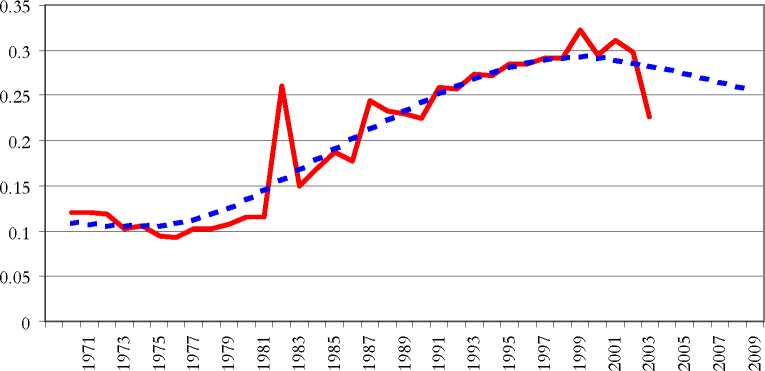4.
ESTIMATION RESULTS
The South African NAWRU
The estimate for the NAWRU of the South African economy is given in figure 2. It is increasing
at a steady rate, suggesting severe structural problems in the economy as a whole, and the labour
market in particular.
Figure 2: South African NAWRU

Actual - s 'Smoothed (Hodrick-Prescott Filter)
The results imply that an “equilibrium” rate of unemployment, and therefore a unique long-run
NAWRU to which the unemployment reverts in the long run, does not exist. This is in line with
a growing number of empirical studies (Pichelmann and Schuh, 1997) that suggests that the
equilibrium unemployment rate may be described by a non-stationary time-series, incorporating
both a deterministic and stochastic trend component.
This increasing rate is attributed to the hysteresis (Pichelmann and Schuh, 1997) nature of
unemployment in South Africa, which in turn is based on the behaviour of labour market
More intriguing information
1. The name is absent2. Rural-Urban Economic Disparities among China’s Elderly
3. Review of “From Political Economy to Economics: Method, the Social and Historical Evolution of Economic Theory”
4. Income Mobility of Owners of Small Businesses when Boundaries between Occupations are Vague
5. THE MEXICAN HOG INDUSTRY: MOVING BEYOND 2003
6. Housing Market in Malaga: An Application of the Hedonic Methodology
7. Studies on association of arbuscular mycorrhizal fungi with gluconacetobacter diazotrophicus and its effect on improvement of sorghum bicolor (L.)
8. The name is absent
9. The name is absent
10. Disentangling the Sources of Pro-social Behavior in the Workplace: A Field Experiment